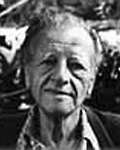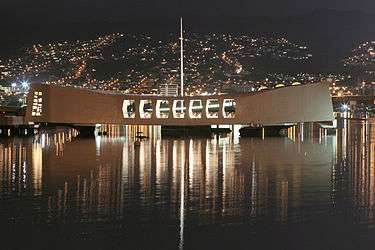Alfred Preis
Alfred Preis (February 2, 1911 – March 29, 1993) was an Austrian-born American architect best known for designing the USS Arizona Memorial in Pearl Harbor.
Alfred Preis | |
|---|---|
 Alfred Preis | |
| Born | February 2, 1911[1] Vienna, Austria-Hungary |
| Died | March 29, 1993 (aged 82) Honolulu, Hawaii |
| Nationality | Austrian |
| Alma mater | Vienna Technical University |
| Occupation | Architect |
| Awards | National AIA award for Arizona Memorial and the First Methodist Church[2] Special Citation for Contribution to the Environment[3] |
| Practice | Redlich und Berger in Austria, then Dahl and Conrad, Hartwood, Associated Architects, and his own office in Honolulu |
| Buildings | USS Arizona Memorial, the entrance of the Honolulu Zoo, the First United Methodist Church, ILWU headquarters (all in Honolulu) |
Early years in Austria
Born and raised in Vienna, Austria, Preis spent his early architecture career in Vienna. He studied at the Vienna Technical University, earned his Architecture diploma in 1938, and worked as a site manager for Redlich and Berger and as a freelance designer for interiors, furniture and store fronts. Although of Jewish background, he converted to Roman Catholicism in 1936. Newlywed, he and his wife fled Austria in 1939 in the face of the German annexation of his homeland and emigrated to the U.S. with the help of the Catholic Refugee Association.[1][4][5][6]:465–467
In Honolulu

Internment
He eventually settled in Honolulu, Hawaii, where he was detained for three months at the Sand Island Detainment Camp in Hawaii after the December 7, 1941, attack as part of the internment policy of Japanese and German Americans.
Career
After his release from internment, Preis worked at the Hawaii Territorial Department of Public Works and later opened his own office.[7]
Preis designed several landmark buildings in Honolulu, including the entrance to the Honolulu Zoo, but is best known for the USS Arizona Memorial. His design for the memorial was selected from those of several other architects. The Navy stipulated that the memorial was supposed to resemble a bridge, handle 200 people and not touch Arizona herself. The original design included portholes where visitors could see the ship beneath the surface. The Navy vetoed this.
The memorial, which was dedicated by John F. Kennedy in 1962, was initially criticized for being a "squashed milk carton" because of its sagging center roof design. Preis responded:
Wherein the structure sags in the center but stands strong and vigorous at the ends, expresses initial defeat and ultimate victory....The overall effect is one of serenity. Overtones of sadness have been omitted to permit the individual to contemplate his own personal responses...his innermost feelings.[6]:462[8]
The memorial is Oahu's biggest tourist destination with 1.5 million visitors a year.[9]
Later years
Preis went on to become a promoter for arts and culture education in Hawaii. He was the first executive director of the Hawaii State Foundation for Culture and the Arts, serving from 1966 to 1980. During this time he championed a successful effort that, in 1967, made Hawaii the first state to require companies to donate one percent of construction costs for public art. Also under Preis' leadership, the HSFCA and the Department of Education established the Artists in the Schools program that provided opportunities for elementary and secondary students in Hawaii schools to work with local professional artists.[10][11]
Preis' ashes were scattered from the memorial. The Hawaii Arts Alliance presents an award known as the Alfred Preis Honor to an individual who demonstrates a lifetime commitment to arts and arts education in Hawaii.[12]
References
- Wicky, Benjamin (ed.). "Architekten im Exil 1933-45 - Biografien - Preis, Alfred" [Architects in exile 1933-45 - Biographies - Preis, Alfred]. kit.edu/kit/english (in German). Karlsruhe, Baden-Württemberg, Germany: Karlsruhe Institute of Technology. Archived from the original on 2013-10-29. Retrieved 2013-10-26.
- "University of Hawaiʻi at Mānoa Campus Heritage Report" (PDF). manoa.hawaii.edu. Honolulu, HI: The Heritage Center, University of Hawai‘i at Mānoa, School of Architecture. 2008. 3:37 (section 3.8.10 Alfred Preis). Retrieved 2013-10-26.
- Radford, Georgia; Radford, Warren; Golt, Rick (1978). Sculpture in the sun : Hawaii's art for open spaces. Honolulu, HI: University Press of Hawaii. p. 95. ISBN 9780824805265. OCLC 4005107.
- Dotson, Bob (2013). "Chapter Five: Stories Hiding in History's Shadow". American story : a lifetime search for ordinary people doing extraordinary things. New York, NY: Viking Press. ISBN 9780670026050. OCLC 830115403.
- Fung Associates, Inc. (November 2011). "Hawaii Modernism Context Study" (PDF). funghawaii.com. Honolulu, HI. pp. 4–128 (130). Archived from the original (PDF) on 2012-03-14. Retrieved 2013-10-28.
- Langmead, Donald (2009). "USS Arizona Memorial, Pearl Harbor, Honolulu, Hawaii". Icons of American architecture from the Alamo to the World Trade Center. Westport, CT: Greenwood Press. ISBN 9780313342080. OCLC 317950915. Retrieved 2013-10-28.
- Hibbard, Don J. (2011). Buildings of Hawaii. University of Virginia Press. pp. 182–183. ISBN 978-0-8139-3094-7.
- "History & Culture - World War II Valor in the Pacific National Monument". nps.gov. Washington, DC: U.S. National Park Service. Retrieved 2013-10-28.
- "What Makes a Good Memorial? - MSN Encarta". Archived from the original on 2009-10-31.
- "History". Hawaii State Foundation for Culture and the Arts. Retrieved 7 December 2011.
- Kam, Nadine (2002-10-07). "Collected works: The State Foundation on Culture and the Arts finally secures a permanent home for its public collection". Honolulu Star-Bulletin. Honolulu, HI: Dennis Francis. Archived from the original on 2010-08-09. Retrieved 2013-11-03.
- "The Alfred Preis Honor" (PDF). Hawaii Arts Alliance. Archived from the original (PDF) on 2012-04-26. Retrieved 7 December 2011.